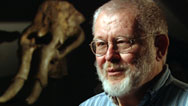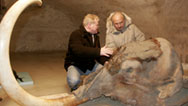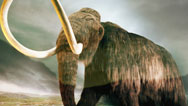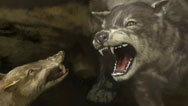Mammoth Mystery
- Posted 07.30.08
- NOVA scienceNOW
In 1962, paleontologists uncovered the rarest of Ice Age fossils in the Nebraska badlands: two complete male mammoths locked in a death grip by their 12-foot-long tusks. What made them fight? And why did they die together? Following forensic clues, paleontologists determine the sex and age of the mammoths, the time of year of their deadly battle, and how their violent clash doomed them.
Transcript
MAMMOTH MYSTERY
PBS Airdate: July 30, 2008
NEIL DeGRASSE TYSON: It was hot and steamy night that made a day on the planet Venus seem like paradise. There was a knock at the door. It was a dame, a dame to make Einstein rethink the fabric of the space-time continuum.
Her case was intriguing: two dead bodies, entangled like a pair of bosons in a shared quantum state; no surviving witnesses. The victims were so big, they made a Panthera tigris look like a pussycat.
And as correspondent Leslie Dodson is about to discover, solving this mystery would take a lot of digging.
LESLIE DODSON (Correspondent): This vault, at the University of Nebraska, is packed with the fossils of extinct Ice Age creatures. It's a collection with an unsolved mystery.
But the bone is in pretty good condition, underneath all...
MIKE VOORHIES: Yeah, the bone is in great shape.
LESLIE DODSON: These bones were unearthed on Nebraska's Badlands, home to species of prehistoric elephants known as mammoths, cousins of the famed wooly mammoths that roamed Arctic regions.
These mammoths were among the largest of all, towering 13 feet high, with massive bodies, weighing up to 10 tons, and tusks reaching out nearly 12 feet long. Despite their fearsome size, their teeth expose them as plant eaters. These were gentle giants, and that makes these particular remains a startling find.
Scientists call this tangle of skulls and bones, "Clash of the Mammoths," two mammoths locked in a death grip. This discovery is unmatched in the fossil record.
MIKE VOORHIES: I've never seen or read about two mammoths locked together. It's absolutely the only one in the world that we know of.
LESLIE DODSON: So if mammoths were such peaceful creatures, why did these two titans end up entangled in death?
The fatal clash took place here, on Nebraska's grassy Badlands, around 12,000 years ago. These grasses extend as far as the eye can see, and they allowed mammoths to thrive and grow to their massive size. Not much has changed here since the entangled mammoths met their untimely end. And they would have gone undetected if not for a chance discovery more than 40 years ago.
In 1962, Ben Ferguson was surveying this land for a dam site, when he stumbled across some unusually large fossils. He called in a team of scientists, including Mike Voorhies.
MIKE VOORHIES: We dug forward and found ribs and the nice skull. This was really exciting. Another few days of digging revealed there were actually two complete mammoth skeletons with their tusks tangled up.
LESLIE DODSON: They knew it was a spectacular find, but lacking the tools to investigate further, they packed up the bones and stored them.
MIKE VOORHIES: It's probably a good thing that the wrappings have remained on these skulls for 40 years, because a lot of the techniques that we're going to be using in studying these mammoths simply weren't there in the 1960s.
LESLIE DODSON: Now, new advances in forensics may help solve the mystery of how the two mammoths died. The first step is understanding mammoth behavior. Unfortunately the last mammoths died after the Ice Age, so we can't observe them, but we can study their modern relatives, elephants.
So, Mike, what do we have here?
MIKE VOORHIES: These are skeletons of a modern-day elephants. Of course, we know elephants are the biggest land animals. Compare these guys with that monster. That is a mammoth!
LESLIE DODSON: So, what clues can elephants give us about why two male mammoths would fight to the death?
MIKE VOORHIES: Well, normally, elephants are very peaceful animals. But it turns out that there's one point in the life of a male elephant that they can get violent. They go into a period called musth, which is a hormone-driven rage. And they can fight. It doesn't really reach a climax until they're in their 30s or 40s. But I've never read or heard about two males actually killing each other.
LESLIE DODSON: Is this what happened to the entangled mammoths?
MIKE VOORHIES: You'd have this other piece.
LESLIE DODSON: To help solve the mystery, Voorhies turns to Dan Fisher, a forensic paleontologist who sees tusks as a window into mammoth life. Fisher extracts samples from tusks to detect the age, nutrition and behavior of mammoths.
DAN FISHER (University of Michigan): Tusks keep growing and growing and growing, throughout the life of the animal. Tusks are essentially formed as a stack of cones, like ice cream cones. The cones out at the tip are those formed early in life, and the end of life is represented back at the base.
LESLIE DODSON: To analyze tusks, Fisher performs his unique brand of dental surgery. Carefully boring small holes and grooves to outline his sample, Fisher uses acrylic polymers to stabilize the fragile ivory and then extracts small cubes of mammoth tusk. He'll repeat this process all along the length of the tusk. Then, he'll use the samples to figure out how old the mammoths were, to see if they were mature enough to display the hormonal rage brought about by musth.
DAN FISHER: The darkest lines there are weeks, and the light lines, in between, are individual days of the animal's life.
LESLIE DODSON: Do we know how old this animal is?
DAN FISHER: This animal was about 40 or so when it died.
LESLIE DODSON: So the two mammoths were the right age, mature males who could experience the rage of musth. Now, can Fisher prove their fatal battle took place in the spring, during mating season, when musth occurs?
Detecting when the fight happened requires micro-surgery. Fisher's team carefully collects powder from about a month's worth of growth lines. Tusks contain a chemical record of what the animals consumed, season by season.
Even after thousands of years, remnants of oxygen from their water and carbon from the green plants that made up their diet can be picked up by a chemical process.
Dan, what are the results here?
DAN FISHER: Well, these values rise in summer, lower in winter and then at the end of life. We've got the end of winter, the beginning of spring; just when they would be going into their mating season.
LESLIE DODSON: But even if they died in the spring mating season, did their bodies contain the testosterone overload from musth to make them fight? One more test.
The growth rings reveal seasonal eating patterns.
DAN FISHER: When they're thicker, it means the animal was eating more, was healthier, growing its tusk faster. When they're thinner, it means there was less to eat and the tusk was growing more slowly.
LESLIE DODSON: But just before the mammoths died, the layers abruptly go thin, unexpected for hearty spring appetites.
DAN FISHER: But it's exactly what you expect in a mature musth male. The hormones trigger a physiological syndrome that involves focusing on mating, focusing on competition. Who cares about eating?
LESLIE DODSON: Fisher's evidence suggests the fighting mammoths were mature adults who engaged in battle during the spring mating season in a fit of hormonal rage: mystery solved. Or is it?
MIKE VOORHIES: I'm not sure. Normally, when two animals are fighting, you've got a winner and a loser.
LESLIE DODSON: When modern elephants clash, fights often last half a day or more. And routinely, the more aggressive bull emerges a clear winner and the loser skulks away. So why did these two mammoths fight to the death?
Voorhies suspects they're missing a piece of evidence. Recently, curators have been cleaning and restoring the fragile remains, stripping plaster and gummy shellac coated on decades ago. Suddenly...
MIKE VOORHIES: Wow!
LESLIE DODSON: ...they've unmasked a startling clue.
MIKE VOORHIES: There's about a one-foot section of bone missing here, from the cheek of this mammoth, and a suspicious fracture here.
DAN FISHER: The form of this fracture is really only consistent with impact from the side. And that would be consistent with a tusk battle where somebody gets a left hook.
MIKE VOORHIES: That's right; a lucky punch on the cheek.
LESLIE DODSON: But how can one good punch possibly result in two dead mammoths?
MIKE VOORHIES: Normally the tusks prevent the animals from locking heads. But in the case of these two mammoths, each of them had one normal tusk and a stub. That made it possible for each animal to use the single tusk as a spear for goring the other guy.
LESLIE DODSON: After repeated attacks, one tusk impales an eye. Then, a fluke collision: the long tusks clamp over the skulls, locking them together. Why can't they simply pull apart?
Voorhies has a theory, but to test it, he has to visit the scene of the battle. Normally, this area is bone dry. But the day our mammoths fought, it's spring. That means rain, and that changes everything.
MIKE VOORHIES: My opinion is that when the Badlands are wet, you can't stand, you can't drive, you can't walk around.
LESLIE DODSON: The slick turf sent the bulls crashing to the ground, but how they fell sealed their fate.
MIKE VOORHIES: The tusks overlapped the heads and the bodies, and they kept the other guy from getting up. They fell in such a way that each of them had basically the full weight of the other one pressing down on him by means of the tusk.
LESLIE DODSON: Their broken tusks are locked in a death grip. Undoubtedly exhausted, the mammoths died in this position, locked together for all time. The 12,000 year old mystery is finally solved.
Credits
Mammoth Mystery
- Edited by
- Terry Hatch
- Directed by
- Kirk Wolfinger
- Produced and Directed by
- Gary Hochman
NOVA scienceNOW
- Executive Producer
- Samuel Fine
- Executive Editor
- Neil deGrasse Tyson
- Senior Series Producer
- Vincent Liota
- Supervising Producers
- Stephen Sweigart
Joey David - Editorial Producer
- Julia Cort
- Development Producer
- Vinita Mehta
- Senior Editor and Colorist
- David Chmura
- Online Editor
- Laura Raimondo
- Series Production Assistant
- Fran Laks
- Assistant Editors
- Susan Perla
Tung-Jen (Sunny) Chiang - Compositors
- Brian
Edgerton
Yunsik Noh - Music
- Rob Morsberger
- NOVA scienceNOW Series Animation
- Edgeworx
- Additional Editing For Mammoth Mystery Segment
- Gary Hochman
- Additional Producing for Phoenix Mars Lander Segment
- Joseph McMaster
- Field Producer For Phoenix Mars Lander Segment
- Anna Lee Strachan
- Associate Producers
- Fran
Laks
Jonathan Loewald
Molly Longstreth
Alison Snyder - Camera
- John Baynard
Brian Dowley
Joe Friedman
Tim Gibbons
Terry Hatch
Max Miller
Brian Seifferlein - Sound Recordists
- John Cameron
Michael Cottrell
Bruce Engler
Tyler Lang
James M. Lenertz
Charlie Macarone
John O'Connor - Sound Mix
- David Chmura
- Animation
- Scott
Beachler
Thomas Floyd
Anthony Kraus
Sputnik Animation
James Laplante
3FX - Assistant Editors for Phoenix Mars Lander segment
- Evelyn
Carrigan
Tyler H. Walk - Production Assistant
- Elizabeth Stachow
- Three dimensional brain animation
- Courtesy Dr. Arthur W. Toga, Laboratory of Neuro Imaging at UCLA
- Archival Material
- BBC Gallery
JPL-Caltech
The Alan Mason Chesney Medical Archives of The Johns Hopkins Medical Institutions
NASA
Plimpton Collection, Rare Book and Manuscript Library, Columbia University
Sveriges Television
Texas A&M University
University of Arizona
University of Nebraska State Museum - Special Thanks
- John Beck
Children's Hospital Boston
Donald Edwards
Sara Hammond
Massachusetts Eye and Ear Infirmary
Trailside Museum - Neil deGrasse Tyson
- is director of the Hayden Planetarium in the Rose Center for Earth and Space at the American Museum of Natural History.
- NOVA scienceNOW Consortium Stations
- Nebraska
Educational Telecommunications, NET
Public Broadcasting for Northern California, KQED
Twin Cities Public Television, TPT
Wisconsin Public Television, WPT - NOVA Series Graphics
- yU + co.
- NOVA Theme Music
- Walter Werzowa
John Luker
Musikvergnuegen, Inc. - Additional NOVA Theme Music
- Ray Loring
Rob Morsberger - Post Production Online Editor
- Spencer Gentry
- Closed Captioning
- The Caption Center
- Publicity
- Carole McFall
Eileen Campion
Lindsay de la Rigaudiere
Victoria Louie
Kate Becker - Senior Researcher
- Gaia Remerowski
- Production Coordinator
- Linda Callahan
- Paralegals
- Raphael Nemes
Sarah Erlandson - Talent Relations
- Scott Kardel, Esq.
Janice Flood - Legal Counsel
- Susan Rosen
- Post Production Assistant
- Darcy Forlenza
- Associate Producer, Post Production
- Patrick Carey
- Post Production Supervisor
- Regina O'Toole
- Post Production Editors
- Rebecca Nieto
Alex Kreuter - Post Production Manager
- Nathan Gunner
- Compliance Manager
- Linzy Emery
- Development Producer
- Pamela Rosenstein
- Business Manager
- Joseph P. Tracy
- Senior Producer and Project Director
- Lisa Mirowitz
- Coordinating Producer
- Laurie Cahalane
- Senior Science Editor
- Evan Hadingham
- Senior Series Producer
- Melanie Wallace
- Managing Director
- Alan Ritsko
- Senior Executive Producer
- Paula S. Apsell
This material is based upon work supported by the National Science Foundation under Grant No. 0638931. Any opinions, findings, and conclusions or recommendations expressed in this material are those of the author(s) and do not necessarily reflect the views of the National Science Foundation.
NOVA scienceNOW is a trademark of the WGBH Educational Foundation
NOVA scienceNOW is produced for WGBH/Boston by NOVA
© 2008 WGBH Educational Foundation
All rights reserved
- Image credit: (mammoth illustration) © WBGH Educational Foundation
Participants
- Leslie Dodson
- Correspondent
- Dan Fisher
- University of Michigan www.eeb.lsa.umich.edu/eeb/people/dcfisher/index.html
- Mike Voorhies
- University of Nebraska State Museum ashfall.unl.edu/meetpaleo.html
Related Links
-

Mammoth Mystery: Expert Q&A
Paleontologist Mike Voorhies, who helped solve the enigma of the entwined mammoths, answers viewer questions.
-

A Mammoth Waste of Time
A 22,000-year-old ball of dung speaks volumes about its maker's life and times.
-

Megabeasts' Sudden Death
Scientists propose a radical new idea of what killed off mammoths and other large animals at the end of the Ice Age.
-

End of the Big Beasts
Overhunting, climate change, disease, and now a comet. What did kill off the megafauna?



